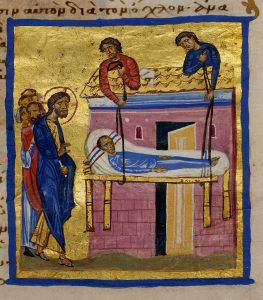 There are six Sundays in the forty day celebration of the Resurrection (corresponding to the forty days until the Ascension as recorded in the Gospel of Luke). The first three Sundays have a gospel of the Resurrection and the second three a gospel with a baptismal theme. Sadly, in our day the baptismal theme of the Feast of Pascha has sometimes been eclipsed, But Paul’s Letter to the Romans makes that connection: “Or are you unaware that we who were baptized into Christ Jesus were baptized into his death? We were indeed buried with him through baptism into death, so that, just as Christ was raised from the dead by the glory of the Father, we too might live in newness of life. (Romans 6:3-4)” This Sunday, we see this is the story of the Paralytic Man. He was without friends, paralyzed for thirty-eight years and unable to get into the pool when the angel touched the waters. However, he finds a friend in our Lord, who asks, “Do you want to be well?” This gospel affirms the sacramental mystery of baptism: it is not the water touched by an angel that cures the man, but the ultimate power of healing comes from the Lord, in the waters of baptism touched by the Holy Spirit sent by the Lord.
There are six Sundays in the forty day celebration of the Resurrection (corresponding to the forty days until the Ascension as recorded in the Gospel of Luke). The first three Sundays have a gospel of the Resurrection and the second three a gospel with a baptismal theme. Sadly, in our day the baptismal theme of the Feast of Pascha has sometimes been eclipsed, But Paul’s Letter to the Romans makes that connection: “Or are you unaware that we who were baptized into Christ Jesus were baptized into his death? We were indeed buried with him through baptism into death, so that, just as Christ was raised from the dead by the glory of the Father, we too might live in newness of life. (Romans 6:3-4)” This Sunday, we see this is the story of the Paralytic Man. He was without friends, paralyzed for thirty-eight years and unable to get into the pool when the angel touched the waters. However, he finds a friend in our Lord, who asks, “Do you want to be well?” This gospel affirms the sacramental mystery of baptism: it is not the water touched by an angel that cures the man, but the ultimate power of healing comes from the Lord, in the waters of baptism touched by the Holy Spirit sent by the Lord.
The Gospel of John is truly a proclamation of the Son of God who sends the Spirit. It also affirms the meaning of baptism, which is the rejection of evil and the commitment to Christ. “Do you want to be well?” Jesus asks, and then the healed man proclaims Jesus as his Healer. Some of the liturgical meaning is lost in some modern Bibles who relegate verse 4 about the angel touching the water to a footnote, as a passage not found in the earliest versions.
“O Christ, cure my soul as you once cured the paralytic man, for it is under the influence of evil and sin. Guide me that I may walk in your paths.” (Ode 5, Matins)
“From time to time an angel of the Lord came to stir up the waters of the pool of the Sheepgate. One man recovered his health, but now an infinite number are saved by Christ through baptism.” (Ode 4, Matins)

 This Sunday presents us with the proclamation of the resurrection according to St. Mark.
This Sunday presents us with the proclamation of the resurrection according to St. Mark.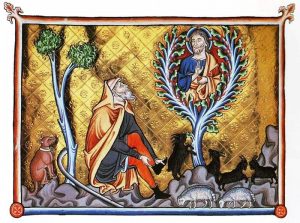 When God appeared to Moses, he first spoke to him from the burning bush. “There the angel of the Lord appeared to him as fire flaming out of a bush. When he looked, although the bush was on fire, it was not being consumed. So Moses decided, “I must turn aside to look at this remarkable sight. Why does the bush not burn up?” (Exodus 3:2-3). Later God was to tell Moses on Mount Sinai, “But you cannot see my face, for no one can see me and live” (Exodus 33:20). Indeed, the Epistle to the Hebrews declares, “our God is a consuming fire” (Hebrews 12:29).
When God appeared to Moses, he first spoke to him from the burning bush. “There the angel of the Lord appeared to him as fire flaming out of a bush. When he looked, although the bush was on fire, it was not being consumed. So Moses decided, “I must turn aside to look at this remarkable sight. Why does the bush not burn up?” (Exodus 3:2-3). Later God was to tell Moses on Mount Sinai, “But you cannot see my face, for no one can see me and live” (Exodus 33:20). Indeed, the Epistle to the Hebrews declares, “our God is a consuming fire” (Hebrews 12:29).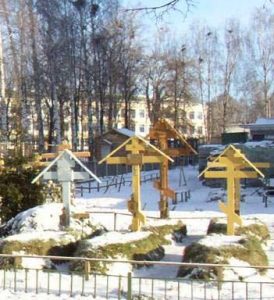 On the first free day after Bright Week [i.e., today], the Church traditionally remembers all those who have fallen asleep. Because of the hope of the resurrection, this is called the “
On the first free day after Bright Week [i.e., today], the Church traditionally remembers all those who have fallen asleep. Because of the hope of the resurrection, this is called the “ Every day during the week of Easter, called Bright Week by the Church, the paschal services are celebrated in all their splendor. The Easter baptismal procession is repeated daily. The royal gates of the sanctuary remain open. The joy of the Resurrection and the gift of the Kingdom of eternal life continue to abound. Then, at the end of the week, on Saturday evening, the second Sunday after Easter is celebrated in remembrance of the appearance of Christ to the Apostle Thomas “after eight days” (John 20.26).
Every day during the week of Easter, called Bright Week by the Church, the paschal services are celebrated in all their splendor. The Easter baptismal procession is repeated daily. The royal gates of the sanctuary remain open. The joy of the Resurrection and the gift of the Kingdom of eternal life continue to abound. Then, at the end of the week, on Saturday evening, the second Sunday after Easter is celebrated in remembrance of the appearance of Christ to the Apostle Thomas “after eight days” (John 20.26).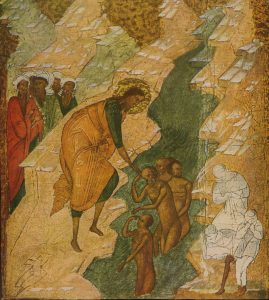 Today is the seventh day of Bright Week, the joyful celebration of the Resurrection of Christ. In today’s Apostolic Reading, St. Peter again proclaims, “The author of life you put to death, but God raised him from the dead; of this we are witnesses” (Acts 3:15). The gospel returns to the theme of baptism, for our life in Christ through the mystery of baptism is the beginning of our share in Christ’s eternal resurrection.
Today is the seventh day of Bright Week, the joyful celebration of the Resurrection of Christ. In today’s Apostolic Reading, St. Peter again proclaims, “The author of life you put to death, but God raised him from the dead; of this we are witnesses” (Acts 3:15). The gospel returns to the theme of baptism, for our life in Christ through the mystery of baptism is the beginning of our share in Christ’s eternal resurrection.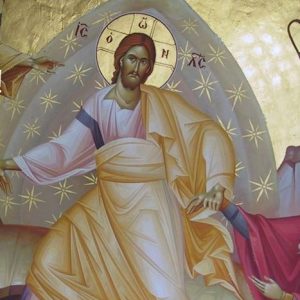 The Catechetical Sermon of St. John Chrysostom is read during Matins of Pascha. This sermon is typically preached by the priest in Byzantine churches on Easter Sunday.
The Catechetical Sermon of St. John Chrysostom is read during Matins of Pascha. This sermon is typically preached by the priest in Byzantine churches on Easter Sunday.